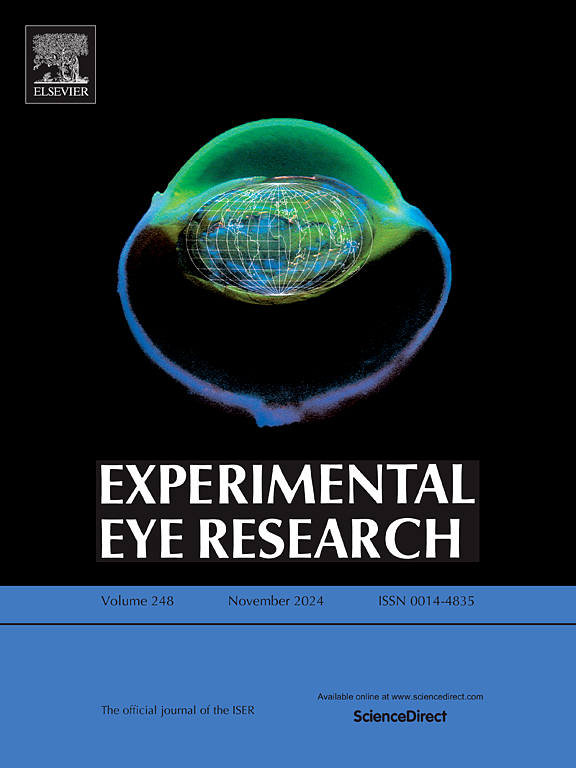Characterization of corneal and retinal changes in a metabolic syndrome model in young and adult mice
IF 3
2区 医学
Q1 OPHTHALMOLOGY
引用次数: 0
Abstract
Introduction
Metabolic syndrome (MetS) is a cluster of metabolic abnormalities, such as central obesity, insulin resistance, dyslipidemia, and hypertension. One of the main characteristics of MetS is the presence of a chronic proinflammatory state, which activates the nuclear factor of activated T cells 5 (NFAT5) in response to the hyperosmolar state.
Methodology
A MetS model was generated in C57BL/6 mice fed to a high-sucrose diet for 120 days. Subsequently, clinical and biochemical parameters were evaluated to confirm MetS. Microvascular changes, histological analysis and the presence of proteins related to NFAT5 activity in inflammation (NLRP3, capase-1) and neurodegeneration (GAP43, GFAP) were evaluated in cornea and retinal tissues.
Results
MetS seems to accelerate the aging process, as young individuals with MetS exhibit characteristics typically seen in normal-weight adults, causes changes in the microvasculature, increasing the in vivo arteriole-to-venule ratio (AVR), in addition to causing NFAT5 relocalization in the retina, which triggers an increase in the inflammasome via NLRP3/caspase-1, in addition to decreasing the presence of GAP43 and GFAP. However, in the cornea, the behavior of NFAT5 is similar, as it relocalizes, but the inflammasome is not fully expressed. Similarly, the levels of the molecules involved in the development of dry eye syndrome, AQP5 and GAP43, are decreased.
Conclusions
Our results revealed a close relationship between MetS and ocular alterations associated with chronic systemic inflammation, which seems to play a central role in the development of these ocular complications.
年轻和成年小鼠代谢综合征模型中角膜和视网膜变化的表征
代谢综合征(MetS)是一组代谢异常,如中枢性肥胖、胰岛素抵抗、血脂异常和高血压。MetS的主要特征之一是存在慢性促炎状态,在高渗状态下激活活化T细胞的核因子5 (NFAT5)。方法C57BL/6小鼠高糖饮食120 d,建立MetS模型。随后,评估临床和生化参数以确认MetS。评估角膜和视网膜组织的微血管变化、组织学分析以及炎症(NLRP3、capase-1)和神经变性(GAP43、GFAP)中与NFAT5活性相关的蛋白的存在。结果MetS似乎加速了衰老过程,因为患有MetS的年轻人表现出正常体重成年人的典型特征,导致微血管的变化,增加体内小动脉与小静脉的比率(AVR),除了引起视网膜中NFAT5的重新定位,通过NLRP3/caspase-1触发炎性体的增加,以及减少GAP43和GFAP的存在。然而,在角膜中,NFAT5的行为是相似的,因为它定位,但炎性体不完全表达。同样,干眼综合征相关分子AQP5和GAP43的水平也会降低。结论我们的研究结果揭示了met与慢性全身性炎症相关的眼部改变之间的密切关系,这似乎在这些眼部并发症的发生中起着核心作用。
本文章由计算机程序翻译,如有差异,请以英文原文为准。
求助全文
约1分钟内获得全文
求助全文
来源期刊

Experimental eye research
医学-眼科学
CiteScore
6.80
自引率
5.90%
发文量
323
审稿时长
66 days
期刊介绍:
The primary goal of Experimental Eye Research is to publish original research papers on all aspects of experimental biology of the eye and ocular tissues that seek to define the mechanisms of normal function and/or disease. Studies of ocular tissues that encompass the disciplines of cell biology, developmental biology, genetics, molecular biology, physiology, biochemistry, biophysics, immunology or microbiology are most welcomed. Manuscripts that are purely clinical or in a surgical area of ophthalmology are not appropriate for submission to Experimental Eye Research and if received will be returned without review.
 求助内容:
求助内容: 应助结果提醒方式:
应助结果提醒方式:


